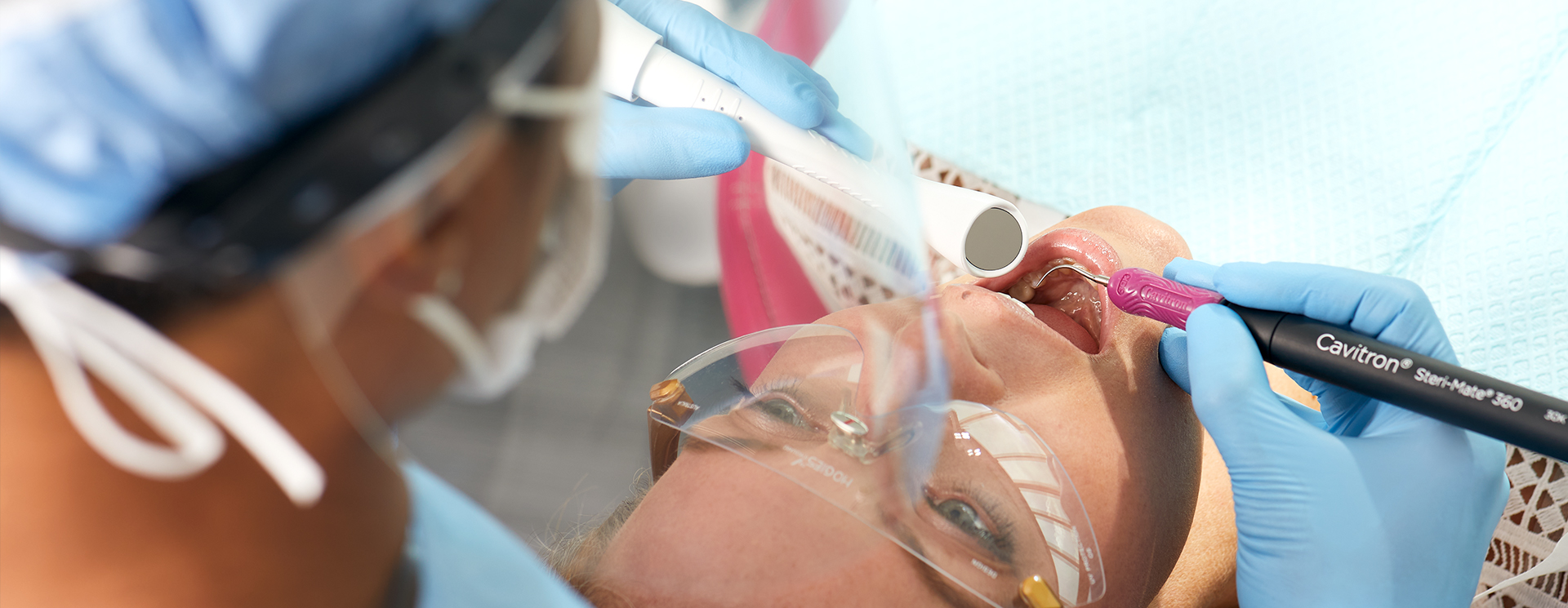

Ultrasonic scaling is an industry-standard for patient care—and Dentsply Sirona can help you take the steps you need to perform it safely.
The recent global health crisis may have changed how we live and work, but one thing will never change: delivering the highest standard of care, using professional judgment, is the dental professional’s first priority. And when it comes to maintaining oral health, utilizing ultrasonic scaling is a proven standard of care.
Let us help you mitigate and manage aerosols and maintain the highest standard of care:
- Book an Infection Prevention Lunch and Learn presentation
- Take hygienist comfort and ease-of-use to new levels, while saving time with Cavitron Ultrasonic Scaling Systems
Benefits
Why Choose Dental Ultrasonic Scalers?



When equal strokes are applied, Cavitron 300 Ultrasonic Scaling removed on average 50% more active biofilm compared to hand scaling in an in vitro study.*



Quickly and effectively remove even the most tenacious calculus³



Preferred by 74% of patients over hand scaling¹



Less pressure, greater comfort for patients and professionals compared to hand scaling⁴



Proven efficiency and versatility²
*Abstract which has been reviewed and presented at IADR
The Right Reasons for Ultrasonic Scaling
As the world leader in dental solutions, Dentsply Sirona wants to help you deliver the highest level of patient care —with the highest level of safety for you, your patients, and your staff.
For Patients
The key to addressing oral diseases is a comprehensive effort that includes education, prevention, and routine dental care.
Research highlights some significant and alarming trends with oral diseases – what has been termed as a “silent epidemic.”5

For Hygienists
- Hygienist comfort has long been a focus in the development of Cavitron ultrasonic scaling units. Consistent research allows for innovative solutions to provide maximum comfort during each procedure.
- Ergonomic features are incorporated into every system, ensuring an intuitive performance and allowing hygienists to focus on patient care.
- Dental professionals experience less pressure and greater comfort during ultrasonic scaling procedures compared to hand scaling.1,8
Cavitron Systems
Cavitron systems lead the competition with innovative features and benefits that enhance the scaling experience. The extensive Cavitron family of products has an ultrasonic scaling unit to fit any office need.
Cavitron Ultrasonic Scaling Inserts
Downloads
1. Croft LK, Nunn ME, Crawford LC, et al. Patient preference for ultrasonic or hand instruments in periodontal maintenance. Int J Periodontics Restorative Dent. 2003;23(6):567-573.
2. Tunkel J, Heinecke A, Flemmig TF. A systematic review of efficacy of machine-driven and manual subgingival debridement in the treatment of chronic periodontitis. J Clin Periodontol. 2002;29 (Suppl3):72-81.
3. Data on file, DENTSPLY Professional.
4. Croft LK, Nunn ME, Crawford LC, et al. Patient preference for ultrasonic or hand instruments in periodontal maintenance. Int J Periodontics Restorative Dent. 2003;23(6):567-573. – Petersen, P. E., & Ogawa, H. (2005, December). Strengthening the Prevention of Periodontal Disease: The WHO Approach.
5. National Center for Chronic Disease Prevention and Health Promotion
6. Albandar JM, Rams TE. Global epidemiology of periodontal diseases. Periodontol 2000. 2002;29:7-10.
7. Petersen, P. E., & Ogawa, H. (2005, December). Strengthening the Prevention of Periodontal Disease: The WHO Approach. Retrieved from http://www.who.int/oral_health/publications/jop2005_76_12_2187.pdf?ua=1
8. Reynolds E. Effectiveness and efficiency in ultrasonic scaling. The Academy of Dental Therapeutics and Stomatology. RDH continuing education course. 2006;1-20.
9. Croft, et al, International Journal of Periodontics & Restorative Dentistry, Volume 23, number 6, 2003.
10. Gatchel RJ, Ingersoll BD, Bowman L, Robertson MC, Walker C. The prevalence of dental fear and avoidance: a recent survey study. J Am Dent Assoc. 1983 Oct;107(4):609–610. [PubMed]
11. Marketing research survey conducted online by a third party, May 2020, among N=254 US adult dental patients. Survey was double blind. Data on file.












